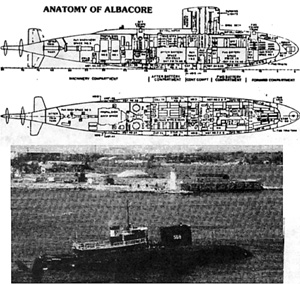(continued from KTB #114)
NEW BEGINNINGS: THE MARRIAGE of MISSILES AND SUBMARINES
Another idea left over from World War II was to launch rockets from surfaced submarines, and this was now made possible by using copies of the German V-1 BUZZ BOMB (called LOON in the U.S. Two BALAO Class fleet boats were converted to launch the LOON guided missile (in today's language it would be called a 'cruise missile'). The modifications necessary were the installation of a large watertight hangar aft of the sail, a launching ramp, and installation of control equipment. Testing of the LOON began in 1947 and continued until 1953 when the REGULUS I cruise missile became available. The REGULUS was essentially a pilotless jet varying a nuclear warhead on a land attack mission. Two more fleet boats were similarly modified to launch REGULUS I between 1953 and 1955. Following launch, the missile could be controlled from snorkel depth out to a range of 200 miles. The REGULUS II missile program was even more extensive in that two dedicated new construction diesel boats and one nuclear powered submarine were built between 1958 and 1960 to launch the missile. However, they had one major design fault. If the REGULUS hangar flooded, the submarine would turn turtle and sink. Three months after the first REGULUS II was test-fired in 1958, the production of new REGULUS II missiles was halted in favor of the new POLARIS missile which could be serviced, adjusted and fired from a submerged submarine.
However, from the late 1950's to 1964, the Navy had at least one REGULUS missile equipped submarine operating in the western Pacific on what would later be known as a 'deterrent patrol'.
USS ALBACORE
 The GUPPY conversion created a submarine which exhibited a pitch instability at high underwater speeds due to its hull form. The David Taylor Model Basin solved this problem by re-discovering what would later be called the 'tear-drop' hull shape. They conducted wind tunnel research on airship hull forms to come up with the ALBACORE hull design. The new hull shape proved very stable at all speeds and offered a drag reduction of about 40% compared with the fleet boat hull shape. Better utilization of internal volume was possible by allowing the machinery to be installed on multiple decks. A single propeller, aft of the stern planes, produced the highest propulsion efficiency. This arrangement, starting with USS ALBACORE (AGSS 569), would become the modern standard.
The GUPPY conversion created a submarine which exhibited a pitch instability at high underwater speeds due to its hull form. The David Taylor Model Basin solved this problem by re-discovering what would later be called the 'tear-drop' hull shape. They conducted wind tunnel research on airship hull forms to come up with the ALBACORE hull design. The new hull shape proved very stable at all speeds and offered a drag reduction of about 40% compared with the fleet boat hull shape. Better utilization of internal volume was possible by allowing the machinery to be installed on multiple decks. A single propeller, aft of the stern planes, produced the highest propulsion efficiency. This arrangement, starting with USS ALBACORE (AGSS 569), would become the modern standard.
USS ALBACORE was commissioned in 1954 as an experimental research submarine with conventional diesel-electric propulsion, but no torpedo tubes. The ship was built to test this high-speed hull form for submerged operations at the expense of any surface seakeeping ability, coming full circle back to John Holland's hull form.
Among USS ALBACORE's research assignments were the usual sonar and acoustic tasks, plus battery and propulsion tests and tests looking at various diving plane arrangements. Other tests involved checking out emergency escape systems, and a test of a unique diving brake system built into the aft section of the sail, similar to an aircraft-type dive brake (one of the many consequences of the loss of USS THRESHER (SSN 593).
USS ALBACORE was a very fast submarine for its day, with a speed of 26 knots for one half hour on the lead acid batteries, or 33 knots (requiring 15,000 SHP) on the new silver-zinc batteries. This was faster than all of her contemporaries, including the 23.3 knot USS NAUTILUS (SSN 571). Also, USS ALBACORE had a faster turning rate than USS NAUTILUS.
In its own right, it was just as revolutionary as the first nuclear powered submarines. USS ALBACORE was decommissioned in 1972, and is now a memorial near the Portsmouth Naval Shipyard where she was built.
After USS ALBACORE, there came the last of the diesel-electric submarines, the BARBEL Class, completed in 1959. These had three diesel engines arranged on two decks (in the same length where other boats would have only had enough room to mount two engines). This class was mainly used for ASW training. They remained in service until 1989.
This paper will continue in KTB #116 next month with EARLY NUCLEAR PROPULSION.
More U.S. Submarines: A Technical History
-
S-Class (#111)
Pre-WWII Build-up and WWII Developments (#112)
Radar and Countermeasures (#113)
Post WWII Period (#114)
Missiles, Subs, and the USS Albacore (#115)
Early Nuclear Propulsion (#116)
Boomers and Fast Attack Submarines (#117)
Polaris and Other Missiles (#118)
Trident Missiles and Attack Subs (#119)
Back to KTB #115 Table of Contents
Back to KTB List of Issues
Back to MagWeb Master Magazine List
© Copyright 1999 by Harry Cooper, Sharkhunters International, Inc.
This article appears in MagWeb (Magazine Web) on the Internet World Wide Web. Other military history articles and gaming articles are available at http://www.magweb.com
Sharkhunters International, Inc., PO Box 1539, Hernando, FL 34442, ph: 352-637-2917, fax: 352-637-6289, e-m: sharkhunters@hitter.net
